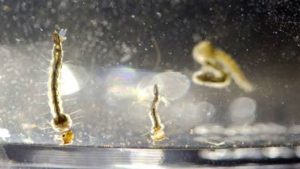
Aedes aegypti mosquito larvae swim in a container at the Florida Mosquito Control District Office in Marathon in August. More federal money finally is available to fight Zika, even as the news worsens. Babies who at first seem to have escaped the virus’ devastating hallmark defect — an abnormally small head at birth — might not be out of the woods after all.
WASHINGTON DC, USA (AP) — More federal money finally is available to fight Zika even as the news worsens. Babies who at first seem to have escaped the virus’ devastating hallmark defect — an abnormally small head at birth — might not be out of the woods after all.
Brazilian doctors have counted a small number of babies who at birth had a normal-sized head and only later were found to have problems. They have delayed neurodevelopment. At five months, one could use one hand but not the other. Later on, some even developed that defect, called microcephaly. The brain and skull weren’t growing properly after birth, instead of before.
“Microcephaly is only the tip of the iceberg, only the thing we see when the baby is born,” Dr Vanessa Van der Linden, a pediatric neurologist in Recife, Brazil, told a meeting at the National Institutes of Health, (NIH) where she outlined a long list of Zika-related abnormalities.
To children’s health experts, the message is clear. Intense study is needed of babies born to Zika-infected mothers to learn the range of health problems they may face.
“It is just critical to evaluate the entire child. Even in the child who does not have microcephaly, that doesn’t mean no evaluation is needed,” said Dr Catherine Spong of the NIH’s National Institute of Child Health and Human Development, which, despite budget constraints, has begun research to better understand the risk to babies.
After months of partisan bickering, Congress last week passed a budget Bill that includes $1.1 billion to address the Zika crisis. It’s just over half the total emergency money that President Barack Obama requested last February.
While mosquito season is winding down in parts of this country, Zika’s threat here and abroad is not diminishing, and that’s why health officials say a sustained commitment is vital.
There are more than 2,200 pregnant women among the 25,600-plus Zika cases that the Centers for Disease Control and Prevention (CDC) counts in US states and territories, mainly Puerto Rico. The vast majority of mainland infections are travel-related, but mosquitoes have been spreading Zika in Florida’s Miami-Dade County.
Out of money over the spring and summer, the Government had raided funds meant for other diseases — Ebola, malaria, tuberculosis, even cancer and heart disease — to research and fight Zika. The new cash infusion will go to mosquito control, other public health measures, and research. At the top of the list is keeping development of a Zika vaccine on track. An initial safety study of an early vaccine candidate is nearly two-thirds enrolled, and Dr Anthony Fauci, NIH’s infectious disease chief, expects a larger study in 2,500 to 5,000 people to test if it works to begin by January.
In the continental US, the CDC says 21 babies have been born with defects attributed to Zika, and doctors are looking to colleagues in harder-hit countries to know what to expect. At the recent NIH meeting, Van der Linden catalogued a sobering list of abnormalities in the most severely affected babies at her Brazilian clinic, the ones born with microcephaly — which by itself can’t indicate the degree of underlying brain damage.
